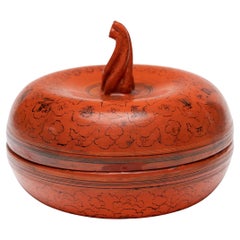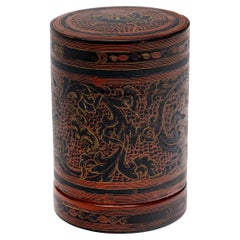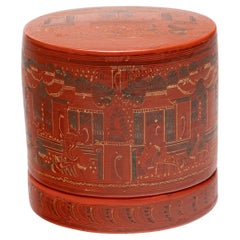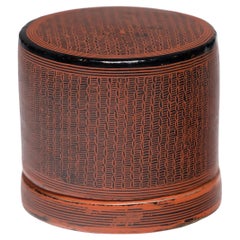Want more images or videos?
Request additional images or videos from the seller
1 of 5
Burmese Yun Lacquer Container, c. 1900
$180List Price
About the Item
- Dimensions:Height: 4 in (10.16 cm)Diameter: 5.5 in (13.97 cm)
- Style:Folk Art (In the Style Of)
- Materials and Techniques:Bamboo,Lacquered
- Place of Origin:
- Period:
- Date of Manufacture:circa 1900
- Condition:Wear consistent with age and use. Minor losses. Minor fading. Minor cracks and losses to lacquer finish.
- Seller Location:Chicago, IL
- Reference Number:Seller: CMRC063C1stDibs: LU820031667342
About the Seller
5.0
Platinum Seller
Premium sellers with a 4.7+ rating and 24-hour response times
Established in 1997
1stDibs seller since 2006
1,727 sales on 1stDibs
Typical response time: 2 hours
Authenticity Guarantee
In the unlikely event there’s an issue with an item’s authenticity, contact us within 1 year for a full refund. DetailsMoney-Back Guarantee
If your item is not as described, is damaged in transit, or does not arrive, contact us within 7 days for a full refund. Details24-Hour Cancellation
You have a 24-hour grace period in which to reconsider your purchase, with no questions asked.Vetted Professional Sellers
Our world-class sellers must adhere to strict standards for service and quality, maintaining the integrity of our listings.Price-Match Guarantee
If you find that a seller listed the same item for a lower price elsewhere, we’ll match it.Trusted Global Delivery
Our best-in-class carrier network provides specialized shipping options worldwide, including custom delivery.You May Also Like
Highly Decorative Antique Burmese Lacquered Betel Box / Kun-It, Circa 1900
Located in Ottawa, Ontario
The vermillion lacquered cylindrical body decorated overall with repeating bands of curvilinear geometric motifs, the cover lifting to reveal both of its original trays intended to h...
Category
Early 20th Century Burmese Lacquer
Materials
Lacquer, Bamboo
Burmese Lacquered and Engraved Wooden Box
Located in Alessandria, Piemonte
Splendid and vintage Burmese Box, red lacquered and engraved, unusual size.
O/5307 -
Category
Vintage 1930s Burmese Other Lacquer
Materials
Wood
18th Century Burmese Rakhine State Lacquer Bamboo Pillow Box
Located in Brea, CA
18th century Burmese black bamboo pillow box in relief with red Rakhine lacquer. Created with bamboo weaving. Decorated all-over with geometrical shapes and...
Category
Antique Early 18th Century Burmese Qing Lacquer
Materials
Lacquer
Burmese Red Carved Wood Temple Offering Box
Located in Moreno Valley, CA
Burmese red lacquered temple offering box called "Hsunok".
Burmese offering basket made of carved bamboo wood painted and lacquered in hues of red and oranges.
The lid adopts a Burmese temple shape, with a sharp top surmounting a gadroon dome.
This kind of basket is used to display offerings to Buddhist temples, in Asia.
During most of the 19th century Burma was ruled by members of the Konbaung dynasty, the last dynasty that would rule the country.
This Asian Burmese red offering...
Category
Early 20th Century South Asian Folk Art Lacquer
Materials
Bamboo
Japanese Marquetry and Lacquer Jewelry Chest, Meiji Period, circa 1900, Japan
Located in Austin, TX
A very attractive Japanese wood table top jewelry or collector's chest with marquetry and lacquer decoration, Meiji period, circa 1900, Japan. Previously in the collection of Asbjorn Lunde (1927 - 2017).
The chest is crafted in the form of a Chinese seal...
Category
Antique Early 1900s Japanese Meiji Lacquer
Materials
Wood, Softwood, Lacquer
$3,400
H 15.75 in W 14.25 in D 7 in
Lacquer Potpourri
Located in Stamford, CT
Lacquer Potpourri box and cover with ormolu mountings from 18th century Directoire Japan/ France.
Category
Antique 18th Century Japanese Lacquer
Materials
Lacquer
Asian Black and Red Round Box Lacquer Offering Vessel Urn
Located in Moreno Valley, CA
South Asian Burmese black and red lacquer box, offering vessel urn with compartment for storage.
This round lacquer ware box from Burma is made from bamboo and lacquer.
In Burma (now...
Category
Late 20th Century Burmese Folk Art Decorative Boxes
Materials
Bamboo
Signed Japanese White Lacquer and Maki-E Lacquer Tansu, Meiji Period
Located in Ottawa, Ontario
The case decorated overall in crackle-glaze white lacquer and fitted with a patinated metal carrying handle over three tiers of small drawers. The first two tiers are comprised of a ...
Category
Antique Late 19th Century Japanese Meiji Lacquer
Materials
Lacquer
Japanese Lacquered Tebako 'Box'
Located in PARIS, FR
Tebako box with three compartments in golden and nashi-ji lacquer, decorated with golden, red, and kirigane lacquer, golden persimmon tree leaves, among rocks. The compartments are of increasing size from the top. The decoration is in continuity.
Persimmon has been cultivated in southern China for more than 2500 years and is believed to have been introduced to Japan in the 8th century. The veneer is a tree with very hard wood, similar to ebony. According to a legend, one specimen survived the atomic bombing of Nagasaki on August 9, 1945, close to the epicenter. It is therefore in Japan a symbol of strength and longevity. It is also the national fruit of the country. It is eaten as a traditional dish during New Year's Day celebrations.
Tebako literally means "portable box...
Category
Antique 1860s Japanese Lacquer
Materials
Lacquer
Chinese Cinnabar Lacquer Cuspidor
Located in New Orleans, LA
This intriguing Chinese zhadou is intricately carved of fine cinnabar lacquer. A work of exceptional artistry, this covered bowl is adorned with an intricately carved floral motif on all surfaces, including the cover and the wide rim. Also known as a cuspidor or spittoon, this rare container would have been used by members of the imperial family and scholar- officials at the court. Carved during the Kangxi period (1662-1722), this charming piece exhibits the high detail and charm associated with items from that period, making it a true treasure,
Early 18th century (Kangxi dynasty)
Measures: 6 ¼” wide x 3 ¼” high
Cinnabar has been revered for its color all over the world. It has been found in the royal burial chambers of the Mayas, in the rituals of India, and in the ruins of ancient Greece and Rome. In China, cinnabar and gold were the two most important elements in alchemy. Mined since the Neolithic Age, cinnabar is the ore of mercury, and as such, it can be incredibly toxic, especially when mining. In fact, during the Roman Empire, miners at Spain’s Almadén mine in Spain were frequently exposed to mercury fumes, and the subsequent, often fatal, sickness was considered an occupational hazard.
The most popular known use of cinnabar is in Chinese carved lacquer-ware, a technique that is believed to have originated in the Song Dynasty, in which cinnabar is ground to a powder and added to clear lacquer. As with mining, there was inherent danger of mercury poisoning for those who carved the lacquer, as mercury was also released into the air when artisans ground the pigments. Most antique cinnabar...
Category
Antique 18th Century Chinese Other Lacquer
Materials
Lacquer
More From This Seller
View AllBurmese Yun Lacquer Gourd Box, c. 1900
Located in Chicago, IL
This late 19th century Burmese red lacquer box is sculpted in the shape of a gourd, pumpkin or melon, a fruit thought to carry blessings of abundance because of its many seeds.
The ...
Category
Antique Late 19th Century Burmese Folk Art Lacquer
Materials
Bamboo
Burmese Yun Lacquer Betel Box
Located in Chicago, IL
Intricately decorated with red and black lacquer, this petite Burmese betel box is a lovely example of a traditional craft. A blend of betel leaves, areca nuts, slaked lime, and some...
Category
20th Century Burmese Folk Art Lacquer
Materials
Bamboo
Burmese Yun Lacquer Betel Box
Located in Chicago, IL
Intricately decorated with red and black lacquer, this petite Burmese betel box (kun-it) is a lovely example of a traditional craft. A blend of betel leaves, areca nuts, slaked lime,...
Category
20th Century Burmese Folk Art Lacquer
Materials
Bamboo
Petite Burmese Yun Betel Box, c. 1900
Located in Chicago, IL
An exquisite example of Burmese artistry, this palm-sized container dates to the late 19th century and was likely originally used as a betel box (kun-it). A blend of betel leaves, ar...
Category
Antique Late 19th Century Burmese Folk Art Lacquer
Materials
Bamboo
Burmese Yun Lacquer Cup, c. 1900
Located in Chicago, IL
This delicate cup from the late 19th century is a lovely example of the Burmese art of lacquer (pan yun). Shaped from coiled bamboo and finished with cinnabar-red lacquer (hinthabada...
Category
Antique Late 19th Century Burmese Folk Art Lacquer
Materials
Bamboo
Burmese Yun Lacquer Footed Bowl, c. 1900
Located in Chicago, IL
Rich with character and antique texture, this Burmese lacquer presentation bowl dates to the late 19th century and is a beautiful example of a traditional craft. A band of etched lin...
Category
Antique Late 19th Century Burmese Folk Art Lacquer
Materials
Bamboo
Recently Viewed
View AllMore Ways To Browse
Betel Box
Antique Betel Box
Asian Containers
Burma Box
Burmese Betel Box
Burmese Yun
Chinese Export Black Lacquer Gilt
Japanese Mother Of Pearl Art
Red Cinnabar
Chinese Cinnabar
Vintage Lacquer
Antique Japanese Tray
Asian Black Lacquer Pearl Furniture
Chinese Cinnabar Furniture
Carved Cinnabar
Cinnabar Lacquer Furniture
Antique Chinese Cinnabar
Japanese Lacquered Tray



